

Image result for harriet tubma. Harriet Tubman - Wikipedia. Born a slave in Dorchester County, Maryland, Tubman was beaten and whipped by her various masters as a child.
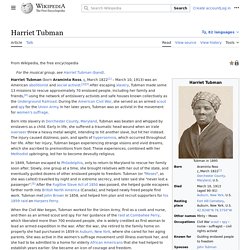
Early in life, she suffered a traumatic head wound when an irate slave owner threw a heavy metal weight intending to hit another slave but hit her instead. The injury caused dizziness, pain, and spells of hypersomnia, which occurred throughout her life. She was a devout Christian and experienced strange visions and vivid dreams, which she ascribed to premonitions from God. Google Image Result for. Harriettubmanbiography. Harriet Tubman - Mini Bio. Harriet Tubman: Former slave who risked all to save others. Image copyright Getty Images Sometime in mid-October 1849, Harriet Tubman crossed the invisible line that borders the state of Pennsylvania.
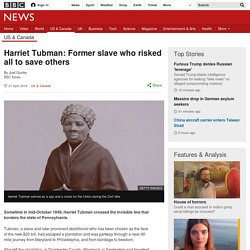
Tubman, a slave and later prominent abolitionist who has been chosen as the face of the new $20 bill, had escaped a plantation and was partway through a near-90 mile journey from Maryland to Philadelphia, and from bondage to freedom. She left the plantation, in Dorchester County, Maryland, in September and travelled by night. Her exact route is unknown, but she probably walked along the Choptank river and journeyed through Delaware, guided by the North Star.
Years later, she recalled the moment she entered Pennsylvania: "When I found I had crossed that line, I looked at my hands to see if I was the same person. Nancy Kwak The Empire State. The Harriet Tubman Home The Harriet Tubman Home preserves the legacy of "The Moses of Her People" in the place where she lived and died in freedom.
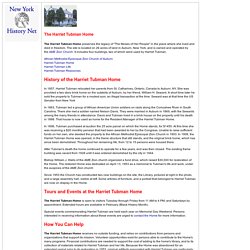
The site is located on 26 acres of land in Auburn, New York, and is owned and operated by the AME Zion Church. America's Library - Library of Congress. Harriet Tubman. Harriet Tubman is perhaps the most well-known of all the Underground Railroad's "conductors.
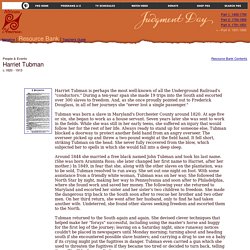
" During a ten-year span she made 19 trips into the South and escorted over 300 slaves to freedom. And, as she once proudly pointed out to Frederick Douglass, in all of her journeys she "never lost a single passenger. " Tubman was born a slave in Maryland's Dorchester County around 1820. At age five or six, she began to work as a house servant. Seven years later she was sent to work in the fields. Around 1844 she married a free black named John Tubman and took his last name. Tubman returned to the South again and again.
By 1856, Tubman's capture would have brought a $40,000 reward from the South. Tubman had made the perilous trip to slave country 19 times by 1860, including one especially challenging journey in which she rescued her 70-year-old parents. Becoming friends with the leading abolitionists of the day, Tubman took part in antislavery meetings. Previous | next. Harriet Tubman - Civil Rights Activist. Harriet Tubman escaped slavery to become a leading abolitionist.
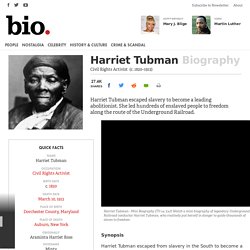
She led hundreds of enslaved people to freedom along the route of the Underground Railroad. Synopsis. National park honoring Underground Railroad heroine Harriet Tubman made official. Harriet Tubman’s coming debut on the $20 is just half the good news in upstate New York where the Underground Railroad conductor settled down.

A long-sought national historical park honoring Tubman could be officially established this summer. (June AP. Harriet Tubman - Black History. In 1849 Tubman fled Maryland, leaving behind her free husband of five years, John Tubman, and her parents, sisters, and brothers.

“Mah people mus’ go free,” her constant refrain, suggests a determination uncommon among even the most militant slaves. She returned to the South at least nineteen times to lead her family and hundreds of other slaves to freedom via the Underground Railroad. Utilizing her native intelligence and drawing on her boundless courage, she eluded bounty hunters seeking a reward for her capture, which eventually went as high as forty thousand dollars.
She never lost a fugitive or allowed one to turn back. Two things sustained her: the pistol at her side and her faith in God. Tubman collaborated with John Brown in 1858 in planning his raid on Harpers Ferry. Tubman’s resistance to slavery did not end with the outbreak of the Civil War. Harriet Tubman: Online Resourcess (Virtual Programs & Services, Library of Congress) The digital collections of the Library of Congress contain a wide variety of material associated with Harriet Tubman, including manuscripts, photographs, and books.

This guide compiles links to digital materials related to Harriet Tubman that are available throughout the Library of Congress Web site. In addition, it provides links to external Web sites focusing on Tubman and a bibliography containing selected works for both general and younger readers. Library of Congress | External Web Sites | Selected Bibliography African American Perspectives: Pamphlets from the Daniel A.
P. An American Time Capsule: Three Centuries of Broadsides and Other Printed Ephemera American Women: A Gateway to Library of Congress Resources for the Study of Women’s History and Culture in the United States A Century of Lawmaking for a New Nation: U.S. Miller NAWSA Suffrage Scrapbooks, 1897-1911 Votes for Women: Selections from the National American Woman Suffrage Association Collection, 1848-1921 Bradford, Sarah H. HARRIET TUBMAN.